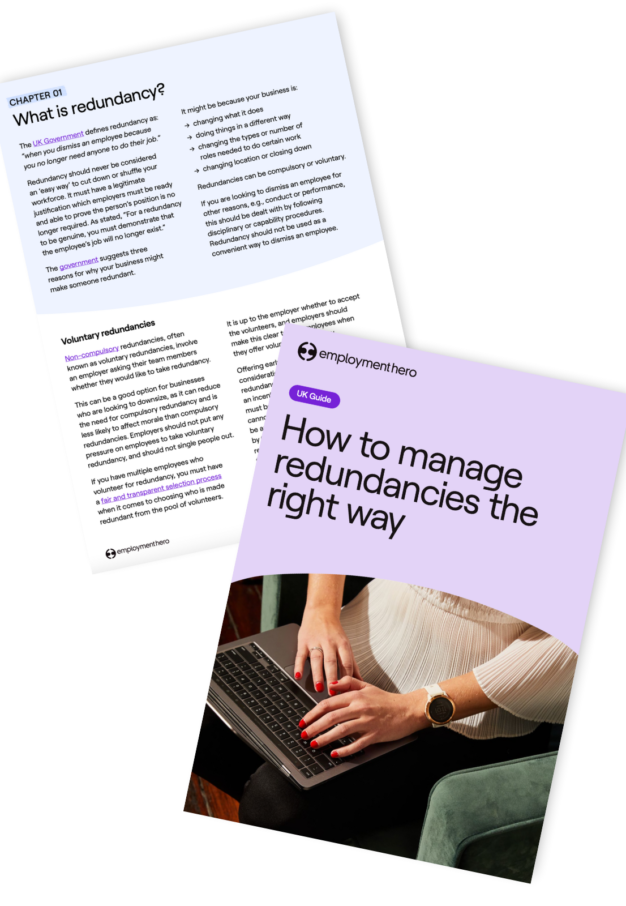
Redundancy has been a big talking point in 2022, and this is expected to continue in 2023.
The most notable recession scandal of recent history is, of course, the dramatic layoffs at Twitter under the new leadership of Elon Musk.
Redundancy, in itself, is not a controversial move for a business. No employer wants to make staff redundant, it is the unfortunate reality that sometimes redundancies are a necessary evil of the business world. Times change, circumstances change, and – as a result – businesses are forced to change in order to adapt.
If you, as an employer or leader, find yourself in a position where redundancies are the only option, our thoughts are with you. Through this guide we hope to help you make it as bearable an experience as possible.
Join us as we talk through compliance as it relates to redundancies, common redundancy mistakes to avoid and how to lead with kindness through the redundancy process.
This guide to redundancy covers;
- What is redundancy?
- Alternatives to redundancy
- Hiring freeze announcement email templates
- The laws and regulations behind redundancy in the UK
- Redundancy the right way
- At risk of redundancy letter template
- Common redundancy mistakes to avoid
Disclaimer: The information in this article is current as at 8 November 2022, and has been prepared by Employment Hero Pty Ltd (ABN 11 160 047 709) and its related bodies corporate (Employment Hero). The views expressed in this article are general information only, are provided in good faith to assist employers and their employees, and should not be relied on as professional advice. The Information is based on data supplied by third parties. While such data is believed to be accurate, it has not been independently verified and no warranties are given that it is complete, accurate, up to date or fit for the purpose for which it is required. Employment Hero does not accept responsibility for any inaccuracy in such data and is not liable for any loss or damages arising either directly or indirectly as a result of reliance on, use of or inability to use any information provided in this article. You should undertake your own research and to seek professional advice before making any decisions or relying on the information in this article.
Download the guide now.

What is employee redundancy?
The UK Government defines redundancy as: “when you dismiss an employee because you no longer need anyone to do their job.”
Redundancy should never be considered an ‘easy way’ to cut down or shuffle your workforce. It must have a legitimate justification which employers must be ready and able to prove the person’s position is no longer required. As stated, “For a redundancy to be genuine, you must demonstrate that the employee’s job will no longer exist.”
Learn more about how redundancy is defined and the different types of redundancy in the UK in our guide.
Why do businesses make people redundant?
The government suggests these reasons for why your business might make someone redundant.
It might be because your business is:
- changing what it does
- doing things in a different way
- changing the types or number of roles needed to do certain work
- changing location or closing down
Redundancies can be compulsory or voluntary.
If you are looking to dismiss an employee for other reasons, e.g., conduct or performance, this should be dealt with by following disciplinary or capability procedures. Redundancy should not be used as a convenient way to dismiss an employee.
What are the alternatives to redundancy?
Before you turn to redundancies, make sure you’ve reviewed all the alternatives first. Let’s take a look at some other options that employers should consider to avoid making redundancies.
Put a hiring freeze in place
A hiring freeze is when companies temporarily stop recruitment for a business.
If your business is in a position where redundancies are on the table, implementing a hiring freeze is a good first alternative option to consider. If there is uncertainty around the future needs of the business, it might be a good idea to consider pausing any plans to grow out the team. Doing so can buy you some time to consider your future strategy.
Employee re-skilling
Moving your team around the business can have numerous benefits. Not only could it help them avoid being made redundant (the ultimate goal), but the person also gets to apply their existing knowledge of the business and your product or service to the new role.
It can help the person diversify their own experience and skill set, and give different areas of your business a fresh perspective.
Read more about 6 of the most in-demand skills for the future of work.
Examine work hours
It could be time to take a look at working hours, and potentially make some temporary alterations to assist with costs.
As with other suggestions in this list, be sure to be transparent with your employees about these requests, and consider their employment contracts closely.
Reduce engagement with freelance or temporary workers
When times get tough, it can be a good idea to reduce the use of freelance or temporary workers for a little while.
While temporary workers are unlikely to have the right not to be unfairly dismissed, there may still be contractual provisions that you need to comply with, and they will still be protected from discrimination, so employers should still take care when reducing engagement with freelance or temporary workers.
Learn more about all of these alternatives to redundancy by downloading the redundancy guide.
Are UK employees entitled to statutory redundancy pay?
Redundancy pay may be applicable in addition to notice pay. This is called a ‘statutory redundancy payment’.
There are requirements for eligibility. An employee must;
- Be working under a contract of employment
- Have had at least 2 continuous years of service
- Have been dismissed, laid off or put on short-time working (those who opted for early retirement do not qualify)
Pay rates are dependent on an employee’s age and length of service.
Visit this government web page to learn more about statutory redundancy pay.
Getting the redundancy process right
Eager to learn more about redundancy? Download the free guide now.
Download the guide now.




